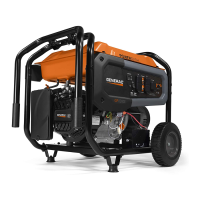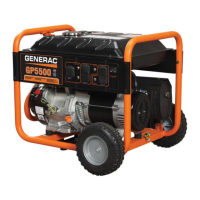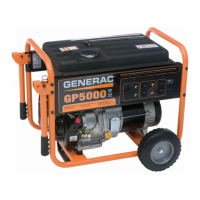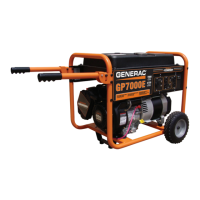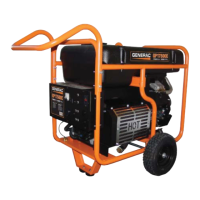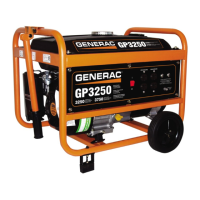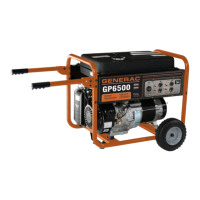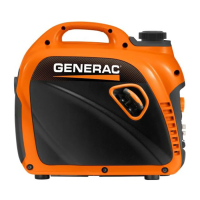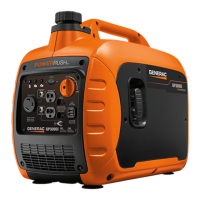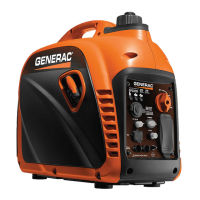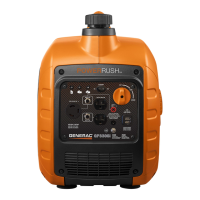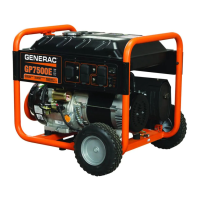Section 4 AC Diagnostic Tests
Diagnostic Repair Manual 43
5. Unplug the six pin connector, or wires to terminals,
at the voltage regulator.
6. See Figure 4-20.
a. Connect the one meter test lead to wire 11S at
terminal block 2 (TB2).
b. Connect the other meter test lead to wire 11S
at the six pin connector previously removed
from the voltage regulator.
c. Continuity should be measured.
7. See Figure 4-20.
a. Connect the one meter test lead to wire 44S at
terminal block 2 (TB2).
b. Connect the other meter test lead to wire 44S
at the six pin connector previously removed
from the voltage regulator.
c. Continuity should be measured.
Results
1. If continuity was not measured in any of the steps
repair or replace defective wire.
2. If all steps pass refer back to flow chart.
Test 11 – Excitation Wiring
Procedure
1. Set DMM to measure resistance.
2. Disconnect connector C1. See Control Panel
Component Identification for connector location.
3. See Figure 4-20. Locate the male side of the
connector located on the bottom of the control
panel.
a. Connect one meter test lead to pin 6 wire 2. It
may be helpful to connect a small jumper lead
to the individual pin.
b. Disconnect wire 2 from the excitation circuit
breaker (CB1). See Control Panel
Component Identification for excitation
circuit breaker location.
c. Connect the other meter test lead to wire 2.
d. Continuity should be measured.
4. Unplug the six pin connector at the voltage
regulator.
5. Locate the male side of the C1 connector located
on the bottom of the control panel.
a. Connect one meter test lead to pin 7, wire 6. It
may be helpful to connect a small jumper lead
to the individual pin.
b. Connect the other meter test lead to wire 6
located in the six pin connector previously
removed from the voltage regulator.
c. Continuity should be measured.
Results
1. If continuity was not measured in any of the steps
repair or replace defective wire.
2. If all steps pass refer back to flow chart.
Test 12 – Check Brush Leads
Procedure
1. Set DMM to measure resistance.
2. Disconnect connector C1. See Control Panel
Component Identification for connector location.
3. See Figure 4-19. Connect the meter test leads
across wire 4 (pin 11) and wire 0 (pin 12) at the C1
connector female side.
a. Rotor resistance should be measured
approximately 7-14 ohms.
b. If resistance is measured proceed to step 6.
c. If no resistance is measured continue.
4. See Figure 4-22. Remove the control panel
assembly to access the brushes.
a. Connect one meter test lead across wire 4 (pin
11) at the C1 connector female side.
b. Connect the other meter test lead to wire 4 at
the brush assembly.
c. Continuity should be measured.
d. If Infinity is measured repair or replace wire 4.
5. See Figure 4-19.
a. Connect one meter test lead across wire 0 (pin
12) at the C1 connector female side.
b. Connect the other meter test lead to wire 0 at
the brush assembly.
c. Continuity should be measured.
d. If Infinity is measured repair or replace wire 0.
6. Unplug the six pin connector at the voltage
regulator.
7. See Figure 4-20. Locate the male side of
connector C1 located on the bottom of the control
panel.
a. Connect one meter test lead to pin 11 wire 4.
b. See Figure 4-11. Connect the other meter test
lead to wire 4 at the six pin connector
previously removed from the voltage regulator.
c. Continuity should be measured.
d. If continuity is not measured repair or replace
wire 4 between the C1 connector and the six
pin voltage regulator connector.
8. Connect one meter test lead to pin 12 wire 0.
Connect the other meter test lead to the ground
terminal in the control panel.
a. Continuity should be measured.
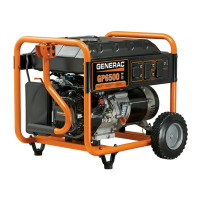
